-
ICMag with help from Phlizon, Landrace Warden and The Vault is running a NEW contest for Christmas! You can check it here. Prizes are: full spectrum led light, seeds & forum premium access. Come join in!
You are using an out of date browser. It may not display this or other websites correctly.
You should upgrade or use an alternative browser.
You should upgrade or use an alternative browser.
:D Genetic Preservation :D - Breeding
- Thread starter acespicoli
- Start date
The HashMan
Member
I don't see why preservation and hybrid seed breeding aimed at growers can't exist side by side.[/quote]
Genetic drift & phenotypic [FONT=Arial, Helvetica, sans-serif]plasticity[/FONT] has a role to play in both fields of breeding
Genetic drift & phenotypic [FONT=Arial, Helvetica, sans-serif]plasticity[/FONT] has a role to play in both fields of breeding
Last edited:
El Timbo
Well-known member
I don't see why preservation and hybrid seed breeding aimed at growers can't exist side by side.
Genetic drift & phenotypic placidity has a role to play in both fields of breeding[/QUOTE]
Did you mean phenotypic plasticity? Sorry but I don't understand how that means both can't exist side by side. Or at least that attempts at preservation can't exist side by side with improving.
The HashMan
Member
Genetic drift & phenotypic placidity has a role to play in both fields of breeding
to truly preserve a land-race you would have to mimic its original environment otherwise it becomes more susceptible to genetic drift, some may say that genetic drift is not possible in clonal organisms, but a great correlation would be that high phenotypic plasticity can cause genetic drift. That just my opinion from observation tho
Last edited:
It also very much involves random mutations and bigger numbers means more chance of beneficial mutations appearing.
Rather than better we might say better suited to the current environment. The benefit of variation in a population is that if the environment changes drastically there is a better chance that some individuals will be better suited to the new environment.
All genes "want" to preserve/reproduce themselves - but some will naturally succeed above others - surely "unnatural" is when we interfere by making selections.
I don't see why preservation and hybrid seed breeding aimed at growers can't exist side by side.
I wasn't talking about outcrossing. I was talking about inbreeding choices, attempts at preservation v attempts at progression. Mutations are the only way for new genes to be introduced in this situation. Most mutations however are damaging rather than enhancing. Therefore, while it is true that the greater the number of breeding individuals, the greater the chance of mutations creating new genes, its also increases, in far greater numbers, negative mutations.
Who are you breeding for? I breed for me. I'm an indoor grower. For me, better means, resembles what I desire to a greater degree. Not will it survive outside in a field somewhere for evermore. And we know that all our efforts will be undone if the population is left to nature.
Genes don't reproduce, individuals do. Every time that happens, 50% of the genes are left behind. Its not that some genes are better at reproducing, but that they are hosted by an individual who is. Is it unnatural for the wolf to take a slow running sheep out of the flock? That's all we are doing in removing plants from breeding pools.
Neither do I. I made my choice, but I'm not hating on anyone for making another choice. But clearly, if I agreed with it, I'd make the same choice. What I object to is people saying that one to one mating is bad.
to truly preserve a land-race you would have to mimic its original environment otherwise its more susceptible to genetic drift, some may say that genetic drift is not possible in clonal organisms, but a great correlation would be that high phenotypic plasticity can cause genetic drift. That just my opinion from observation tho
To truly preserve an accession, you do not grow it. Well, not any more than absolutely necessary.
You grow large populations in conditions that allow the maximum number of plants to reproduce. Those seeds go in long-term storage, only to be reproduced if viability starts to approach worrying territory.
Ideally, by the time you’re growing out p3 or 4, you’re able to do it at the place of origin - sociopolitical conditions should change a lot over 50-100 years. ‘Course, all bets are off as we race towards global oblivion....
romanoweed
Well-known member
I personally dont try to preserve that Survival Traits for compleetly new Climates. If you want to acclimatize Thai at Mount everest, it is just such a crazy Goal, and possibly will not be reached. If you even want to acclimatize to California, wich is quiet as sunny as Thailand, but just quiet, then i just heard too many bad experiences of People trying it..
What is important for me personally with preservation is that i allow a Strain to live forever. Like said avoiding inbreeding depro.
So, i am more focussed on a optimal future-scenario of my Thai-Lines. This optimal scenario can acording most Folks only be a Growenviroment close to its Origin-enviroment. Be it artificial indoors, or a similar Latitude ( say Mexico), the conditions have to be approximatly same (lightintensity, temperatures and so forth) in order to allow a fullpower thai-effect. Thats what i heard so often.
I personally have another viewpoint as zif. I have no real believe it will ever become legal in a way that people are freely allowed to do and let what they wish in Thailand. Also, by now many Thaipeople like to grow Skunk... you would need to shield pollen with Greenhouses heating up till they burn if there is to much Skunk. And like mentioned the extent on wich landraces were grown once is also to take into account. With it i mean the amount of diverse selection (selection of people on a nearby hill, selection in a valley, selection of young people, selection of elders, eveything concentratet in the seed it produces) I dont know when the day will arise we reach that extent again. Probably one day..
Thats why i stick with my Solution, trying to imitate what once was happening with Landraces. Shure i will only try to reproduce the Seedstock as rarely as needed. But man, there are many other reasons to learn Thai-breedingstyle. I dont wanna sit on a small batch of Seeds without to enjoy them, i also wanna do real breeding too, wich for me is Landrace style breeding. What thai people did thats what i wanna do. If i propagated a Thai in a way that it truely is the same as before then my Breeding Goal is reached.
I experienced real 70s Thai, and therefore i have a good Trust that whatever they did in their Breedingpocess was so right, no it was exeptional! Absolutely insane it was.
I mean i assume what i smoked was not even a hard to find pheno, and thai produced actually a good amount of good phenos according some old Stoners.
What is important for me personally with preservation is that i allow a Strain to live forever. Like said avoiding inbreeding depro.
So, i am more focussed on a optimal future-scenario of my Thai-Lines. This optimal scenario can acording most Folks only be a Growenviroment close to its Origin-enviroment. Be it artificial indoors, or a similar Latitude ( say Mexico), the conditions have to be approximatly same (lightintensity, temperatures and so forth) in order to allow a fullpower thai-effect. Thats what i heard so often.
I personally have another viewpoint as zif. I have no real believe it will ever become legal in a way that people are freely allowed to do and let what they wish in Thailand. Also, by now many Thaipeople like to grow Skunk... you would need to shield pollen with Greenhouses heating up till they burn if there is to much Skunk. And like mentioned the extent on wich landraces were grown once is also to take into account. With it i mean the amount of diverse selection (selection of people on a nearby hill, selection in a valley, selection of young people, selection of elders, eveything concentratet in the seed it produces) I dont know when the day will arise we reach that extent again. Probably one day..
Thats why i stick with my Solution, trying to imitate what once was happening with Landraces. Shure i will only try to reproduce the Seedstock as rarely as needed. But man, there are many other reasons to learn Thai-breedingstyle. I dont wanna sit on a small batch of Seeds without to enjoy them, i also wanna do real breeding too, wich for me is Landrace style breeding. What thai people did thats what i wanna do. If i propagated a Thai in a way that it truely is the same as before then my Breeding Goal is reached.
I experienced real 70s Thai, and therefore i have a good Trust that whatever they did in their Breedingpocess was so right, no it was exeptional! Absolutely insane it was.
I mean i assume what i smoked was not even a hard to find pheno, and thai produced actually a good amount of good phenos according some old Stoners.
G
Guest
Thanks man.It's on the official Paradise website.... information section a few + pages in
Kerala × Skunk #1 × Afghan
Backcrossed to the Afghan × ?
I'd put my money on it being a Kandahar
View Image
View Image
I made S1 seeds from the Kerala phenotype
Pic for reference: The front plant is the best indica phenotype I found growing 8 S1 seeds out to maturity
View Image
Dried bud of best indica phenotype:
View Image
I also made S2 seeds
Namaste
Do you have a link or name of the article, I went thru the first 5+ pages. I did find this about Durga Mata:
https://www.paradise-seeds.com/en/info/what-makes-a-classic-indica-strain/What Are Durga Mata’s Classic Indica Strain Characteristics?
Durga Mata is the combination of two Indica landraces - Afghani and Himalyan – from the same Hindu Kush region.
Ganja 13
Member
https://www.paradise-seeds.com/en/info/paradise-seeds-history/
It didn't link sorry....Page 8
Paradise Seeds History: Amsterdam Roots + Sensi Star Shines!*
Your welcome
It didn't link sorry....Page 8
Paradise Seeds History: Amsterdam Roots + Sensi Star Shines!*
Your welcome
Last edited:
romanoweed
Well-known member
Some more Thoughts
Lets try to imagine the broadness of Genes in a given Landrace.
Lets assume we crossed all the Landraces together, Thai , Columbian, Afghan, African Indian ,whatever. So we get the broadest Genetic Base there can be. like shown in the Graph in Blue Points.
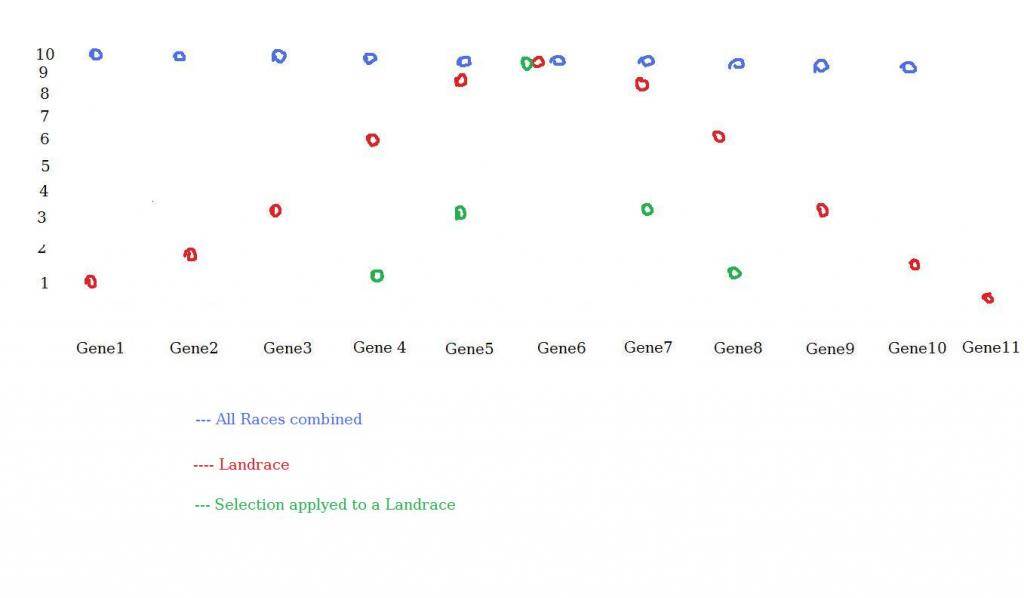
We heard that Landraces have a slight Selection, a genetic Narowing, but they are not compleetly bottlenecked like a 1 to 1 Mating would do. like shown in Red.
They are pretty adapted to a Region, and shure Thai derivering from humid Jungle would have a hard Time growing in Afghanistan. Therefore the Genetical Base is narrowed, i think enviroment is a major reason for Genetic narrowing, but also how often Humans in the good old Times exchanged Genetics from far away, wich i guess was not the norm, but shure happend to a small degree.
So we just limit the Curve for the Landrace a bit ( Red). Cause some Genes are pretty unexistent in Thai Landrace, per example drought Resistance would only occur in a Deserted Place.. So the Thai Genetic based is Limited to a Base wich only occurs in Thailand. We illustrate that in a Bellcurve, and where there are no Genes illustrated, thats the furthest away of a Genetic (like drought resistance)
Lets assume we do a Selection from this Thai Landrace . Namely we do a 1 to 1 Mating from the one of a 1000s Pheno, the best pheno. We agree thats gonna narrow the Genetic Base, right?
Probably it narrows it,i cant actually proove it, but just agree for now that it does, so i can show you what i mean. So, narrowed Genetic shown in Green curve.
-------
Like said , its possibly that heavy bottlenecking in 1 to 1 matings will cause inbreeding depression. So lets look for other possibilities.
Lets look how i illustrate you how keeping multiple Phenos would compare.
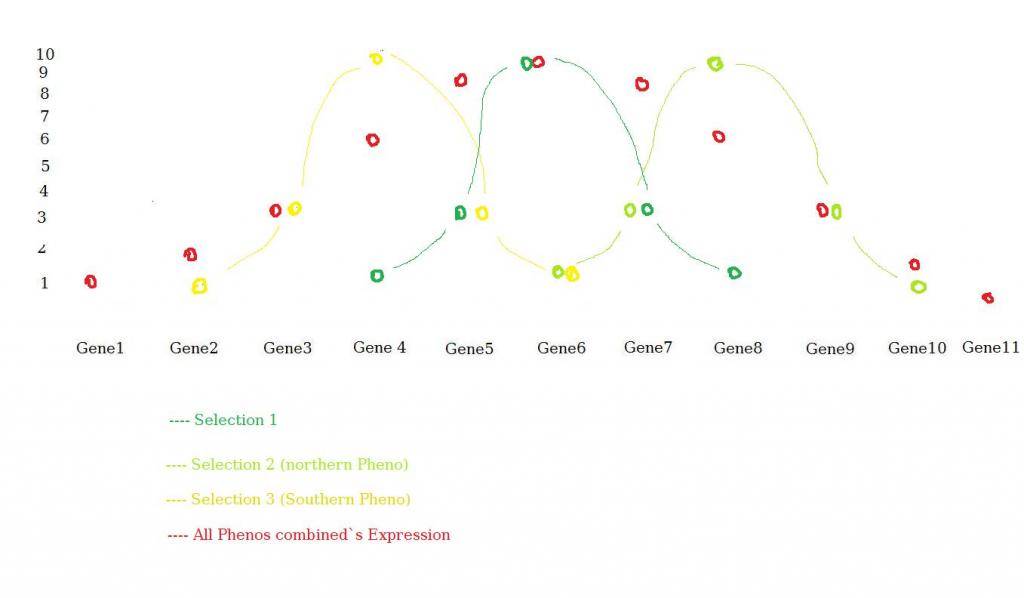
You would simply make use of more Phenos for the the next Generation.
Different to the Pheno you used for the 1to1 Mating, you logically would choose Phenos of different look. One might be a more northern Pheno that might have bit more Anchestry from the north, also a southern Pheno that has more Anchestry from the South. And many more Phenos you choose..
Each Pheno by itselve would probably not be what you dream of. The northern Phenon is to less Potent, the Southern Pheno is too spiritual, to airy in Effect.
But all Phenos combined , passed on to the next Generation will form that broader Genetic Base of the initial Landrace (red).
What i wanna say with it is: You may think if a Landrace shows the the one of a 1000s super Pheno, then thats all you have to select for. But as i wanted to demonstrate, all Phenos with a certain different Expression combined would actually form that broad Bellcurve of a Landrace. The landrace Bellcurcve (Genetic Base) is broader than the Bellcurve created by a 1 to 1 Mating .
And Landraces have prooven to be the strongest weed on earth,
and that 1 to 1 Mating might sooner or later show its Difference from the Landrace, even it didnt make use of the Powerless northern Pheno, nor the to spiritual southern Pheno, no it was really using the one of a 1000s killer Pheno. USING it, but that does not necessarly mean that it will fully keep the Thai Landrace as it initially was.
This initial Thai Landrace provided that killer Pheno. So much we know.
Lets try to imagine the broadness of Genes in a given Landrace.
Lets assume we crossed all the Landraces together, Thai , Columbian, Afghan, African Indian ,whatever. So we get the broadest Genetic Base there can be. like shown in the Graph in Blue Points.
We heard that Landraces have a slight Selection, a genetic Narowing, but they are not compleetly bottlenecked like a 1 to 1 Mating would do. like shown in Red.
They are pretty adapted to a Region, and shure Thai derivering from humid Jungle would have a hard Time growing in Afghanistan. Therefore the Genetical Base is narrowed, i think enviroment is a major reason for Genetic narrowing, but also how often Humans in the good old Times exchanged Genetics from far away, wich i guess was not the norm, but shure happend to a small degree.
So we just limit the Curve for the Landrace a bit ( Red). Cause some Genes are pretty unexistent in Thai Landrace, per example drought Resistance would only occur in a Deserted Place.. So the Thai Genetic based is Limited to a Base wich only occurs in Thailand. We illustrate that in a Bellcurve, and where there are no Genes illustrated, thats the furthest away of a Genetic (like drought resistance)
Lets assume we do a Selection from this Thai Landrace . Namely we do a 1 to 1 Mating from the one of a 1000s Pheno, the best pheno. We agree thats gonna narrow the Genetic Base, right?
Probably it narrows it,i cant actually proove it, but just agree for now that it does, so i can show you what i mean. So, narrowed Genetic shown in Green curve.
-------
Like said , its possibly that heavy bottlenecking in 1 to 1 matings will cause inbreeding depression. So lets look for other possibilities.
Lets look how i illustrate you how keeping multiple Phenos would compare.
You would simply make use of more Phenos for the the next Generation.
Different to the Pheno you used for the 1to1 Mating, you logically would choose Phenos of different look. One might be a more northern Pheno that might have bit more Anchestry from the north, also a southern Pheno that has more Anchestry from the South. And many more Phenos you choose..
Each Pheno by itselve would probably not be what you dream of. The northern Phenon is to less Potent, the Southern Pheno is too spiritual, to airy in Effect.
But all Phenos combined , passed on to the next Generation will form that broader Genetic Base of the initial Landrace (red).
What i wanna say with it is: You may think if a Landrace shows the the one of a 1000s super Pheno, then thats all you have to select for. But as i wanted to demonstrate, all Phenos with a certain different Expression combined would actually form that broad Bellcurve of a Landrace. The landrace Bellcurcve (Genetic Base) is broader than the Bellcurve created by a 1 to 1 Mating .
And Landraces have prooven to be the strongest weed on earth,
and that 1 to 1 Mating might sooner or later show its Difference from the Landrace, even it didnt make use of the Powerless northern Pheno, nor the to spiritual southern Pheno, no it was really using the one of a 1000s killer Pheno. USING it, but that does not necessarly mean that it will fully keep the Thai Landrace as it initially was.
This initial Thai Landrace provided that killer Pheno. So much we know.
Ganja 13
Member
Nice !
acespicoli
Well-known member
I have Acquaah's 'Principles of plant genetics and breeding'
In it he says (about inbreeding depression) - " The effect of inbreeding is most significant in the first 5-8 generations, and negligible after 8 generations in most cases "
he was talking about naturally outcrossing species like cannabis.
On a more general note:
I think it's great that people want to do the best job they can in preserving landraces etc, and i applaud them for it....
BUT i also like to smoke very strong, tasty weed and i also applaud everyone who crosses plants or self plants to achieve that too. I don't feel i need to pick sides...
All these techniques imo - outcrossing/inbreeding/selfing are best thought of as tools in a toolbox - to be used where appropriate and people should be open minded about the best one to use in each situation.
If you were building yourself a car, its unlikely that you would be ok using the spanners/wrench, but flatly refuse to use a screwdriver!
VG
 everyone has made some very substantial points
everyone has made some very substantial points agree totally
collective goals personal goals all mutually beneficial to the plant.
Just picked up a pdf of that book im gonna spend some time on it and try to expand my understanding past Mendels pea experiments
thx for sharing that VG
https://gtu. ge/Agro-Lib/Principles%20of%20Plant%20Genetics%20and%20Breeding.pdf
[FONT=Arial, Helvetica, sans-serif][SIZE=+2]Population Genetics
[/SIZE][/FONT][FONT=Arial, Helvetica, sans-serif][SIZE=+1]Below is a review of the various population genetics models covered in lab. [/SIZE][/FONT]
[/SIZE][/FONT][FONT=Arial, Helvetica, sans-serif][SIZE=+1]Below is a review of the various population genetics models covered in lab. [/SIZE][/FONT]
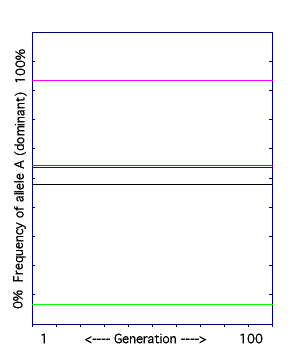
A. The Hardy-Weinberg Model.
The frequency of the dominant allele (A) in a population is graphed over 100 generations. The following rules are in effect: the population is large, there is no migration of individuals, mating is random, there is no natural selection, and no mutation.
The frequency of the dominant allele (A) in a population is graphed over 100 generations. The following rules are in effect: the population is large, there is no migration of individuals, mating is random, there is no natural selection, and no mutation.
The result: there is no change in allele frequencies over time. The model was run five times (see the different colored lines) and each time, the allele frequency at the first generation equals the allele frequency at the last generation.
This does not mean that genotype frequencies can't change over time. For example, consider two small populations, each with two individuals. Population 1: AA and aa. Population 2: Aa and Aa. The genotypes of the individuals in the populations are different, but the allele frequencies are the same in both populations: 50% A and 50% a.
This does not mean that genotype frequencies can't change over time. For example, consider two small populations, each with two individuals. Population 1: AA and aa. Population 2: Aa and Aa. The genotypes of the individuals in the populations are different, but the allele frequencies are the same in both populations: 50% A and 50% a.
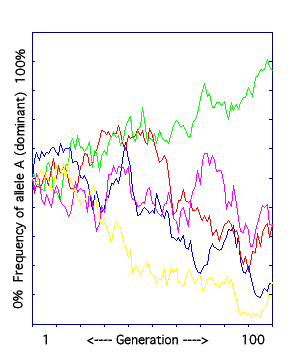
The frequency of the dominant allele in a small population (less than 100 individuals) is graphed over 100 generations.
Genetic drift is change in allele frequencies due to random events. It most strongly effects small populations. Consider two populations, each with 50% genotype AA and 50% aa. Population C has two individuals while Population D has 5000. An aa individual in each population dies. In Population C the allele frequencies change from 50% A and 50% a to 100% A, while in Population D there is almost no change in frequencies.
The result: allele frequencies change randomly (and unpredictably) over time. The model was run five times, always starting with the same allele frequency. The final allele frequency was always different, though sometimes higher and sometimes lower than at the start.
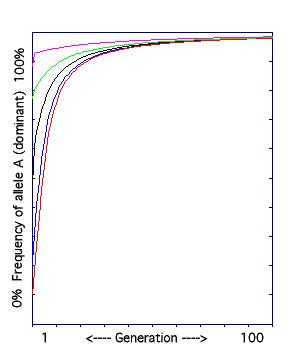
The frequency of the dominant allele is graphed over 100 generations. The dominant phenotype is selected for.
In natural selection, having a certain trait makes an individual more reproductively successful than individuals lacking the trait. Thus, the allele that codes for the favored trait is passed on to more offspring, and becomes more common over time.
The result: the frequency of the dominant allele goes up over time. However, notice how the lines flatten as the frequency of the recessive allele drops. It is almost impossible to totally eliminate recessive alleles from a population, because if the dominant phenotype is what is selected for, both AA and Aa individuals have that phenotype. Individuals with normal phenotypes but disease-causing recessive alleles are called carriers.
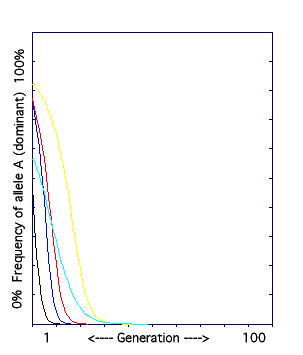
D. The Natural Selection Model II: recessive allele favored.
The frequency of the dominant allele is graphed over 100 generations. The dominant phenotype is selected against.
In this model, the recessive phenotype is selected for, and the dominant phenotype is selected against. (Perhaps the dominant allele causes a rare and lethal disease.)
The result: each of the five times that the model was run, the frequency of the dominant allele dropped to zero. The dominant allele was eliminated from the population even when its frequency was very high to begin with. When the dominant phenotype is selected against, any individual with even one dominant allele will have the undesirable trait, and so will have few or no offspring. In a relatively short time, only the aa individuals with the selected for recessive trait will be left. This is called purifying selection.
particularly like the hover dictionary term pop ups thx Gypsy
The frequency of the dominant allele is graphed over 100 generations. The dominant phenotype is selected against.
In this model, the recessive phenotype is selected for, and the dominant phenotype is selected against. (Perhaps the dominant allele causes a rare and lethal disease.)
The result: each of the five times that the model was run, the frequency of the dominant allele dropped to zero. The dominant allele was eliminated from the population even when its frequency was very high to begin with. When the dominant phenotype is selected against, any individual with even one dominant allele will have the undesirable trait, and so will have few or no offspring. In a relatively short time, only the aa individuals with the selected for recessive trait will be left. This is called purifying selection.
particularly like the hover dictionary term pop ups thx Gypsy
acespicoli
Well-known member
El Timbo
Well-known member
Neither do I. I made my choice, but I'm not hating on anyone for making another choice. But clearly, if I agreed with it, I'd make the same choice. What I object to is people saying that one to one mating is bad.
Good - and no one (on this thread) has said that... it's a shame that a thread about to go about preservation has turned into a preservation v breed for improvement discussion.
Good - and no one (on this thread) has said that... it's a shame that a thread about to go about preservation has turned into a preservation v breed for improvement discussion.
There was discussion about inbreeding depression and how quickly it might happen. I thought it would be relevant to ask GMT, who has actually bred cannabis lines in multiple generations and is one of the most knowledgeable breeders here (both in practice and theory), about his experiences.
Difficult to discuss preservation without mentioning improvement because they are, in some ways, the two extremes of a sliding scale, and most people will be making compromises/balances between the two
VG
Last edited:
The HashMan
Member
the hardy-weinberg equilibrium doesn't account for cannabis and its polymorphic nature, its useful as a baseline in controlled breeding projects to track genetic markers, but I wouldn't use it to define the genetic inheritance of 100+ generations of land-race.
Let's see if I can win El Timbo over.
Within any closed population, in nature, the rate of genetic drift that occurs is due not to population numbers, but due to mutation rates within the line. Let's look at sharks, alligators/crocodiles, and the like. They are almost unchanged in 10's of millions of years. They also don't suffer from cancer. Cancer is caused by a mutation in a cell. Now this change occurs during mitosis rather than meiosis, which is where most new genes are created. However the mutation rate is inheritable. Other animals with higher mutation rates, such as dogs, will change very quickly. They also have quite high levels of cancer.
Therefore genetic drift can also be referred to as evolution or mutation in the majority of cases.
If you do what Darwin did, and visit closed populations in nature, the rate of evolution depends not on population numbers, but mutation rates of the species there.
So when we move our attention to fungi, we can look at mushrooms which are older than any animal, they appear unchanged in form, however each mushroom puts out roots with differing DNA at each root tip (Paul stamets) in order to find the most useful for the next mushroom. But the mushroom doesn't change its basic form. They have mastered the concept of evolution without changing their basic form.
So let's look at plants. In any population, you have a base starting position, you get the advantageous mutation, and it spreads throughout the population. After some time passes, that advantageous mutation is passed to all offspring. Now that gene is everywhere. Is that bad? Did nature do a bad thing by failing to preserve the old gene? The point is, an advantageous gene, eventually spreads throughout the whole population. No individuals posses the older gene. So when people talk about preservation, they are assuming that different examples within the population hold different genes. But they don't. Genes pass through closed groups and every member of that group hold the same genes.
You only get different genes within any population, when you have travel between communities.
As people we see this in our own populations, and so assume it is the case with all populations. It isn't.
If you find a particular landrace there will not be any individual left over time, that doesn't share the same genes as every other member of that landrace, unless its a mitosis induced mutation, which is normally a bad thing. That individual wouldn't represent the majority anyway. The big difference in DNA content, isn't in the individual gene differences, but in the gene ratios.
As meiosis occurs, if the mother has 5 copies of one gene, then one offspring may inherit 1 copy and the next 4 copies or 2 and 3 or whatever. The same will happen from the father. So offspring will in theory have between 0 and 10 copies of that gene. This is where genetic differences are found. Not in gene differences, but in gene copy frequencies.
So preservation will be the act of generating a line with an average number of copies of all genes. This requires careful selection of parents, or large numbers of parents. Either will achieve the same goal. Only poor selection will alter the averages and generate genetic drift. Not due to losing genes, but reducing their frequency.
This is why one to one mating can both preserve a line, and create genetic drift in a line depending on selections. However, in most cases, future selections can reverse the direction of any drift occurring. If that's what is desired. Or it can exaggerate that drift. But to think that unless you start with 2000 plants, you are losing genes, I feel, misses the point of how closed populations evolve and survive.
In short, the ability to preserve, depends on the mutation rates of the line, rather than the numbers in the line. The higher the rate of mutation, the larger the base numbers would need to be. But to think they need to be in the thousands is buying into the sophestry that protects the big players in the industry.
Within any closed population, in nature, the rate of genetic drift that occurs is due not to population numbers, but due to mutation rates within the line. Let's look at sharks, alligators/crocodiles, and the like. They are almost unchanged in 10's of millions of years. They also don't suffer from cancer. Cancer is caused by a mutation in a cell. Now this change occurs during mitosis rather than meiosis, which is where most new genes are created. However the mutation rate is inheritable. Other animals with higher mutation rates, such as dogs, will change very quickly. They also have quite high levels of cancer.
Therefore genetic drift can also be referred to as evolution or mutation in the majority of cases.
If you do what Darwin did, and visit closed populations in nature, the rate of evolution depends not on population numbers, but mutation rates of the species there.
So when we move our attention to fungi, we can look at mushrooms which are older than any animal, they appear unchanged in form, however each mushroom puts out roots with differing DNA at each root tip (Paul stamets) in order to find the most useful for the next mushroom. But the mushroom doesn't change its basic form. They have mastered the concept of evolution without changing their basic form.
So let's look at plants. In any population, you have a base starting position, you get the advantageous mutation, and it spreads throughout the population. After some time passes, that advantageous mutation is passed to all offspring. Now that gene is everywhere. Is that bad? Did nature do a bad thing by failing to preserve the old gene? The point is, an advantageous gene, eventually spreads throughout the whole population. No individuals posses the older gene. So when people talk about preservation, they are assuming that different examples within the population hold different genes. But they don't. Genes pass through closed groups and every member of that group hold the same genes.
You only get different genes within any population, when you have travel between communities.
As people we see this in our own populations, and so assume it is the case with all populations. It isn't.
If you find a particular landrace there will not be any individual left over time, that doesn't share the same genes as every other member of that landrace, unless its a mitosis induced mutation, which is normally a bad thing. That individual wouldn't represent the majority anyway. The big difference in DNA content, isn't in the individual gene differences, but in the gene ratios.
As meiosis occurs, if the mother has 5 copies of one gene, then one offspring may inherit 1 copy and the next 4 copies or 2 and 3 or whatever. The same will happen from the father. So offspring will in theory have between 0 and 10 copies of that gene. This is where genetic differences are found. Not in gene differences, but in gene copy frequencies.
So preservation will be the act of generating a line with an average number of copies of all genes. This requires careful selection of parents, or large numbers of parents. Either will achieve the same goal. Only poor selection will alter the averages and generate genetic drift. Not due to losing genes, but reducing their frequency.
This is why one to one mating can both preserve a line, and create genetic drift in a line depending on selections. However, in most cases, future selections can reverse the direction of any drift occurring. If that's what is desired. Or it can exaggerate that drift. But to think that unless you start with 2000 plants, you are losing genes, I feel, misses the point of how closed populations evolve and survive.
In short, the ability to preserve, depends on the mutation rates of the line, rather than the numbers in the line. The higher the rate of mutation, the larger the base numbers would need to be. But to think they need to be in the thousands is buying into the sophestry that protects the big players in the industry.
El Timbo
Well-known member
I understand that GMT - and I know I am not qualified to discuss population numbers.
I'm more interested in recognising the value of someone, somewhere preserving land race populations so that at some point down the line they could be called upon to produce hybrids for growers.
The question is whether or not small time hobbyists can do it... and I'm also unqualified to answer that question.
I'm more interested in recognising the value of someone, somewhere preserving land race populations so that at some point down the line they could be called upon to produce hybrids for growers.
The question is whether or not small time hobbyists can do it... and I'm also unqualified to answer that question.
...... The higher the rate of mutation, the larger the base numbers would need to be. But to think they need to be in the thousands is buying into the sophestry that protects the big players in the industry.
Great and thought provoking post, thanks.
This last line particularly jives with me... a few years back there seemed to be an ideology forming and being pushed that it was somehow irresponsible to practice breeding cannabis unless you could run massive numbers - and that we should all use clones instead! - of course in an ideal world clones are better, but with canna illegal in most places still, seeds are easier to move around, hide, preserve etc etc.
VG



